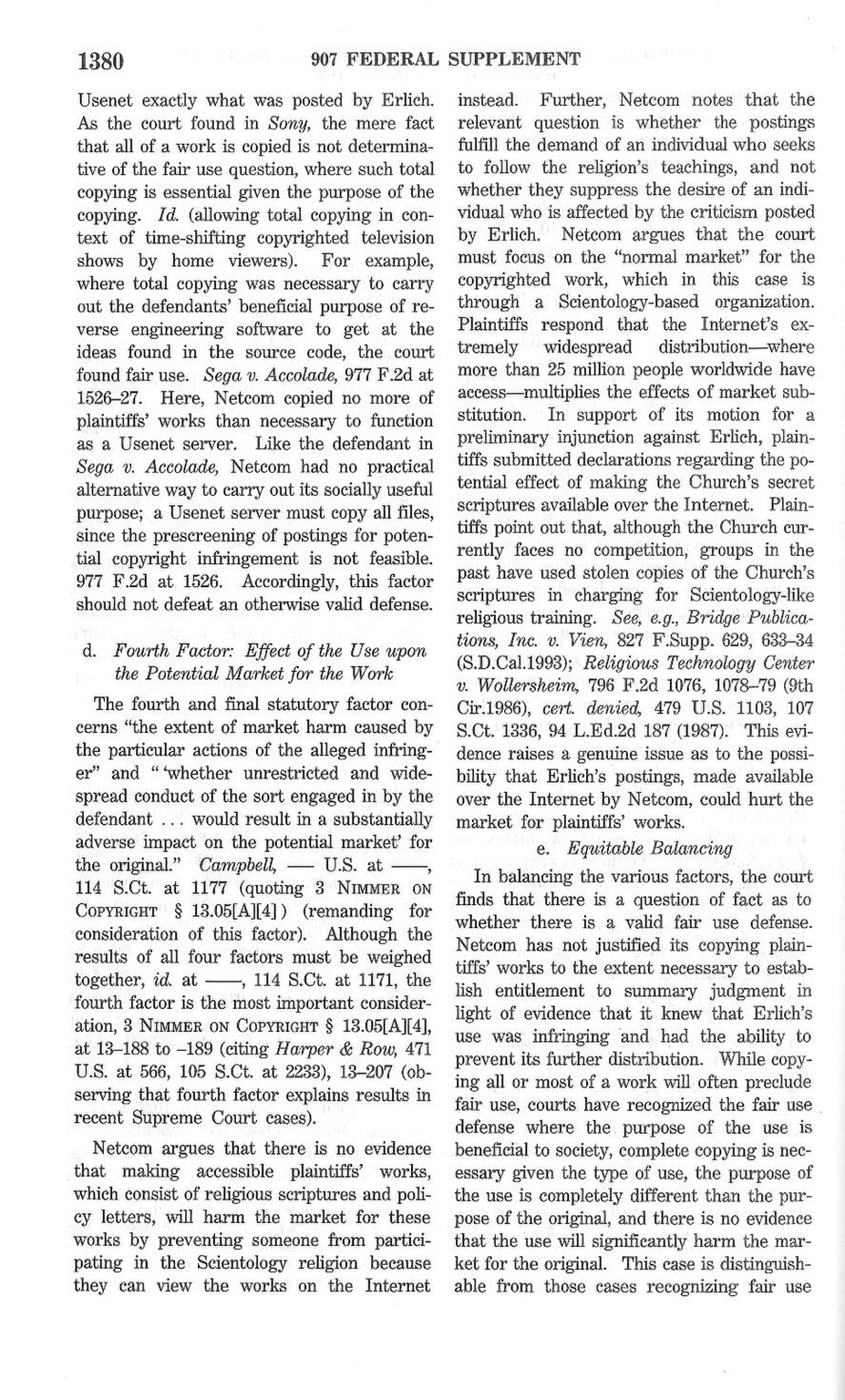Usenet exactly what was posted by Erlich. As the court found in Sony, the mere fact that all of a work is copied is not determinative of the fair use question, where such total copying is essential given the purpose of the copying. Id. (allowing total copying in context of time-shifting copyrighted television shows by home viewers). For example, where total copying was necessary to carry out the defendants’ beneficial purpose of reverse engineering software to get at the ideas found in the source code, the court found fair use. Sega v. Accolade, 977 F.2d at 1526–27. Here, Netcom copied no more of plaintiffs’ works than necessary to function as a Usenet server. Like the defendant in Sega v. Accolade, Netcom had no practical alternative way to carry out its socially useful purpose; a Usenet server must copy all files, since the prescreening of postings for potential copyright infringement is not feasible. 977 F.2d at 1526. Accordingly, this factor should not defeat an otherwise valid defense.
d. Fourth Factor: Effect of the Use upon the Potential Market for the Work
The fourth and final statutory factor concerns “the extent of market harm caused by the particular actions of the alleged infringer” and “ ‘whether unrestricted and widespread conduct of the sort engaged in by the defendant … would result in a substantially adverse impact on the potential market’ for the original.” Campbell, – U.S. at —, 114 S.Ct. at 1177 (quoting 3 Nimmer on Copyright § 13.05[A][4]) (remanding for consideration of this factor). Although the results of all four factors must be weighed together, id. at —, 114 S.Ct. at 1171, the fourth factor is the most important consideration, 3 Nimmer on Copyright § 13.05[A][4], at 13-188 to -189 (citing Harper & Row, 471 U.S. at 566, 105 S.Ct. at 2233), 13-207 (observing that fourth factor explains results in recent Supreme Court cases).
Netcom argues that there is no evidence that making accessible plaintiffs’ works, which consist of religious scriptures and policy letters, will harm the market for these works by preventing someone from participating in the Scientology religion because they can view the works on the Internet instead. Further, Netcom notes that the relevant question is whether the postings fulfill the demand of an individual who seeks to follow the religion’s teachings, and not whether they suppress the desire of an individual who is affected by the criticism posted by Erlich. Netcom argues that the court must focus on the “normal market” for the copyrighted work, which in this case is through a Scientology-based organization. Plaintiffs respond that the Internet’s extremely widespread distribution—where more than 25 million people worldwide have access—multiplies the effects of market substitution. In support of its motion for a preliminary injunction against Erlich, plaintiffs submitted declarations regarding the potential effect of making the Church’s secret scriptures available over the Internet. Plaintiffs point out that, although the Church currently faces no competition, groups in the past have used stolen copies of the Church’s scriptures in charging for Scientology-like religious training. See, e.g., Bridge Publications, Inc. v. Vien, 827 F.Supp. 629, 633–34 (S.D.Cal.1993); Religious Technology Center v. Wollersheim, 796 F.2d 1076, 1078–79 (9th Cir.1986), cert. denied, 479 U.S. 1103, 107 S.Ct. 1336, 94 L.Ed.2d 187 (1987). This evidence raises a genuine issue as to the possibility that Erlich’s postings, made available over the Internet by Netcom, could hurt the market for plaintiffs’ works.
e. Equitable Balancing
In balancing the various factors, the court finds that there is a question of fact as to whether there is a valid fair use defense. Netcom has not justified its copying plaintiffs’ works to the extent necessary to establish entitlement to summary judgment in light of evidence that it knew that Erlich’s use was infringing and had the ability to prevent its further distribution. While copying all or most of a work will often preclude fair use, courts have recognized the fair use defense where the purpose of the use is beneficial to society, complete copying is necessary given the type of use, the purpose of the use is completely different than the purpose of the original, and there is no evidence that the use will significantly harm the market for the original. This case is distinguishable from those cases recognizing fair use
